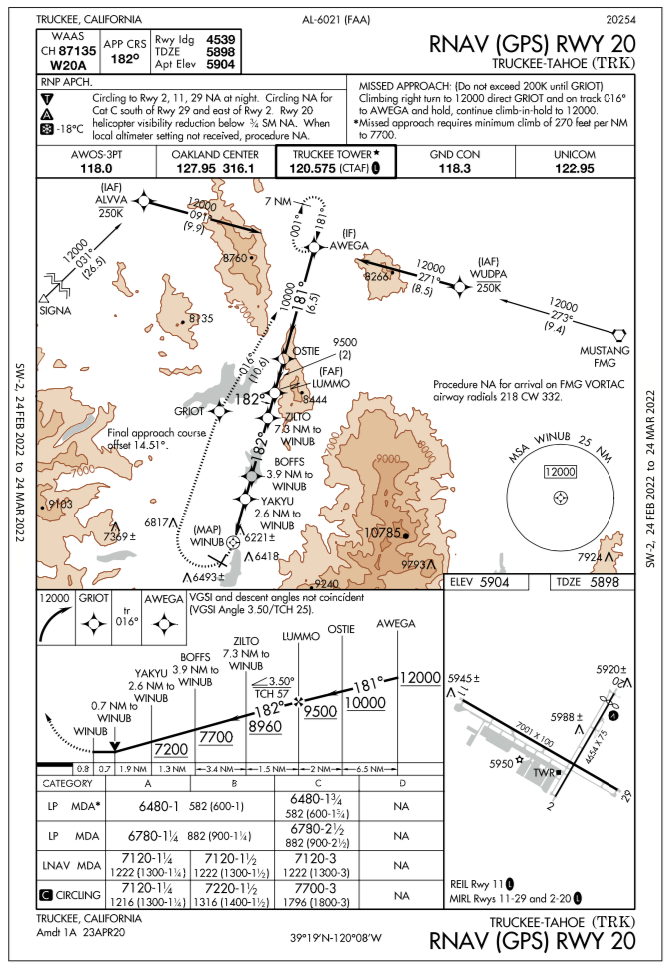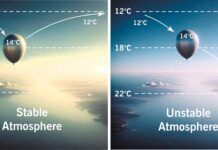While we train for the essential ability to fly approaches to minimums, that’s not always enough preparation for real-life weather, which can conjure up things that don’t fit neatly into the ceiling/visibility numbers on the charts. Sometimes it’s not clear: Am I at those minimums? Do I have the visual minimums to cancel? Should I continue, or miss? Surprises happen, but we can have Plans A and B (and sometimes C) ready to lessen the odds of a snap decision. And if flying under 14 CFR Part 91, it’s largely up to the PIC whether to continue for that landing under IFR or VFR, with few legal constraints.
Approach Choice
Here’s an example from the NTSB files. A pilot and passenger flying a TBM 700 escaped with minor injuries following a go-around and crash at Truckee-Tahoe Airport (KTRK) near Lake Tahoe, California. It was December 2009, 1738 local time, around dusk. According to the NTSB’s report, the probable cause was “The pilot’s failure to maintain an adequate airspeed and clearance from terrain during an attempted go-around. Contributing to the accident was the pilot’s decision to land on a partially obscured runway.” It happens: Breaking out of the clouds and seeing the runway or runway lighting in front of you, thus meeting §91.175. But sometimes you’re not seeing those objects clearly due to thin clouds, mist, or snow. Continue or miss? Depends on what else is going on. But flying the missed approach, even if it seems safer than continuing to the runway in partial obscuration, is a high-workload procedure for single-pilot IMC.
Other factors come into play here. The NTSB report states the aircraft departed San Carlos, California, (KSQL) for the hour flight northeast to Truckee. The pilot’s plan after obtaining local weather was to fly the RNAV 19 with a circle to land on Runway 28, as 19 was closed. (The airport has changed since; there’s a tower and runway numbering is now 2/20 and 11/29. Procedures were likely amended.)
Visibility at the time was seven miles, according to the pilot’s account, while the ceiling wasn’t definitive. The pilot indicated having ground visibility but wasn’t sure exactly when the aircraft broke out of the clouds. The report described conditions a few minutes before the crash as: dusk, one-mile visibility, scattered clouds at 100 feet, broken ceiling at 1500, winds 090 degrees at four knots. Snow was listed on the report as a possible obscuration. The temperature/dewpoint were -2C/-3C.
The accident report stated the pilot wanted to use the 7000-foot Runway 28. Reports indicated it was either snowing or had recently snowed. The weather would have been just below the ceiling minimum for the GPS-A, so presumably, the pilot chose the GPS 19 approach with its circling MDA of 7220-1½ for a Category B aircraft that was lower than the GPS-A’s 7500-1¼.
The reported visibility was one mile, although the pilot determined flight visibility was better; it’s not uncommon for flight vis to be better than reported. The RNAV’s 19 MAP, WINUB, is 0.8 NM from the threshold. The report describes what happened near the fix: “…the pilot established visual contact with the airport’s runway environment and canceled his instrument flight rules clearance.” This indicates the TBM wasn’t quite at WINUB and the pilot determined it was okay at that point to continue visually. The pilot also reported “light rime” icing on the airframe before breaking out and cancelling. He then flew left downwind for 28, presumably overflying mid-field over the crossing runways.
Unplanned Miss
Two critical decisions took place. The first is cancelling IFR at dusk in what appeared to be marginal VFR, with airframe icing. Some pilots favor cancelling IFR on the ground even if on a visual approach, just for insurance and perhaps to trim workload. Others advocate cancelling as soon as practical, mainly to open up the airport for the next one in line for departure or approach (and for some of us, to avoid forgetting).
So there’s flexibility, but it’s worth noting that when cancelling IFR, you’re immediately VFR and the cloud-clearance rules are mandatory. While it’s uncertain how far below the clouds the TBM was upon cancelling, a 1500-foot ceiling was about the minimum for an IFR circling approach. In lower conditions, it’ a big risk to cancel when you might have to miss and fly into marginal VMC or enter IMC without an IFR clearance.
Next is the pilot’s decision to fly the approach to a closed runway and circle to another. While on its face this was necessary to have the lower MDA and with only one runway (the longer one) available, the gotta-circle pressure left the pilot in a tight spot. And it wasn’t just the weather. The only approaches currently listed at KTRK are the RNAV 11, 20, and RNAV-A.
The airport sits amid terrain and obstructions in the area, including a ski resort. The report narrative states that after circling, “the pilot noticed that the first part of the runway was covered in fog and that the visibility was ¾ of a mile with light snow. With at least 5000 feet of clear runway, he opted to land just beyond the fog.” This led to a sudden third decision, to land long in sudden low visibility. It was clearly unplanned and added to the growing list of risks.
Would the cancelled IFR flight plan have been a factor in pressuring the pilot to continue? Possibly, and this resulted in another last-second choice when the pilot realized there wasn’t enough runway after all and began the go-around and aircraft clean-up. “During the go-around, the pilot focused outside the airplane cockpit but had no horizon reference in the dark night conditions. He heard the stall warning and realized that the aircraft was not climbing. The pilot pitched the nose down and observed only snow and trees ahead. Not being able to climb over the trees, the airplane subsequently impacted trees and terrain, coming to rest upright in a wooded, snow-covered field. The pilot stated that there were no anomalies with the engine or airframe that would have precluded normal operation of the airplane.”
The pilot’s telephone statements to the NTSB differ slightly in that he determined “at least 4000 feet” of runway remained clear. Also, he was “too high and fast,” prompting the go-around, and after raising the gear, he mistook the stall warning as the gear horn.
He had considerable time in the TBM and recent flying hours would indicate familiarity with the aircraft, but the report did not offer details on recent instrument time, instrument currency or recent training events. Even under IFR, snow with near-dark conditions can still cause disorientation to even the most experienced, especially during a sudden a go-around into IMC.
In Hindsight
Turning to the perennial dilemma of the missed-approach-from-a-circling-approach, the closed runway was likely the first link in the chain, followed by a sudden shift in conditions. If both runways were open, flying the RNAV 20 approach with 4539 feet of landing distance available (as currently published) would have worked for most light aircraft and smaller turbines such as the TBM 700. If it’s not adequate for the aircraft, or the PIC simply prefers the longer runway, circling to 29 is still an option. The RNAV 20 has circling minimums for Category B of 7220-1½.
The TBM pilot had visual contact with the “runway environment,” determined visibility was good so it was legally okay, but not if the obscuration suddenly blocked his view of the runway or lighting. Perhaps a go-around still would have been the safest action even if no longer under IFR. But the obscured runway, a long landing in progress followed by a “high and fast” aircraft (which happens under high workload and pressure) all but made a go-around inevitable. The disorientation and near-stall flight condition were the final links that led to the crash.
Anticipating worse-than-forecast weather and setting personal minimums for any given flight often means going beyond the two numbers listed on an approach and formulating a plan that accounts for challenging situations. That plan can always be to go sooner, later, or tomorrow, when it’s VFR, etc. That can keep the pressure off and avoid split-second decisions. Here, other options include avoiding circling or remaining IFR to make available missed approach guidance and, if need be, a clearance to an alternate. Otherwise, the likelihood of pressing on when only a few hundred feet from the runway will not only break rules, but the risk threshold of the pilot.
Elaine Kauh is a CFII in eastern Wisconsin. She produces safety articles and seminars based in part on real-life scenarios. They are designed for educational purposes and do not reflect any actual pilot’s personal minimums, decisions or judgment.





